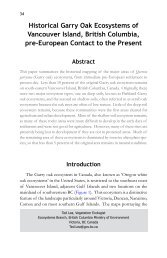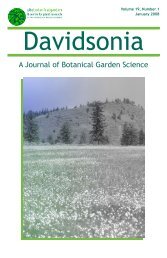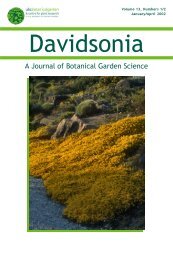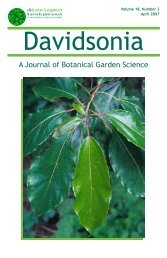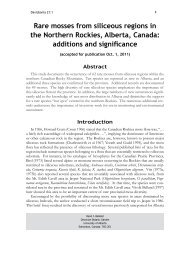pdf wkg Dav.14-14 - Davidsonia
pdf wkg Dav.14-14 - Davidsonia
pdf wkg Dav.14-14 - Davidsonia
You also want an ePaper? Increase the reach of your titles
YUMPU automatically turns print PDFs into web optimized ePapers that Google loves.
<strong>Davidsonia</strong> <strong>14</strong>:4<br />
127<br />
habitats within a forested matrix since most of the rare species were found<br />
in open areas. Harrison (1999) has investigated two hypotheses on California<br />
serpentines that may also apply at Grasshopper Mountain: 1. that there is<br />
edaphic control of competitive dominance and 2. that there is edaphic resistance<br />
to invasion of non-native species.<br />
Species Ranges<br />
The location of Grasshopper Mountain within the coast-interior climatic<br />
transition zone results in a mix of floristic elements with phytogeographical<br />
affinities to the coast, the interior, and the south; consequently, many species<br />
occur at the edge of their ranges (Tables 4 through 6). Several of these are<br />
species of interior BC occurring at the western edge of their ranges on the<br />
dry, ultramafic sites of Grasshopper Mountain. The presence of a few taxa,<br />
including Pseudoroegneria spicata subsp. inermis and Eriogonum ovalifolium var.<br />
nivale, may represent westward range extensions (Douglas et al. 1998-2002).<br />
Two conifers, Pinus albicaulis and Pinus ponderosa, occur at the lower and upper<br />
limits of their ranges, respectively.<br />
Plant Species as Soil Indicators<br />
Following the indicator classification scheme proposed by Kruckeberg<br />
(1979, 1992), the plant species of Grasshopper Mountain were grouped into<br />
local ultramafic indicator species, local ultramafic excluded species, and<br />
widespread (bodenvag) species (Tables 4 through 6). Within each indicator<br />
group, taxa were further subdivided into functional groups based on site<br />
moisture affinity (see Douglas et al. 1998-2002), and plant life forms that<br />
have previously been shown to respond to ultramafic soil conditions<br />
(Whittaker 1954; Kruckeberg 1979, 1992). Species occurring in less than<br />
10% of plots on a given substrate, and species found primarily on tillinfluenced<br />
soils, have been omitted from this classification.<br />
Thirty-five species are good indicators of local ultramafic conditions at<br />
Grasshopper Mountain (Table 4). However, the majority of these species<br />
are known to occur elsewhere on non-ultramafic soils. Their association<br />
with ultramafic soils at the study site may be a function of exclusion from<br />
the mostly well-developed mesic forests of the non-ultramafic side. For<br />
instance, 24 of the 35 indicator species are dry habitat associated herbs, and<br />
a number of species from other functional groups in this category are also



